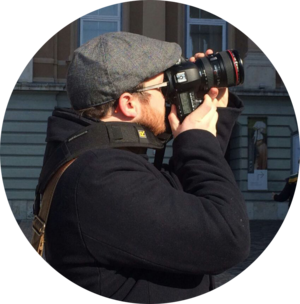What is the Rule of Thirds?
The Rule of Thirds is the quickest and easiest composition technique to learn and implement.
Simply put it is dividing the frame using 3 horizontal and 3 vertical lines to create 9 boxes.
Where the lines cross should be the focal point or subject of the photograph, which leads to a very interesting composition.
It couldn’t be much easier!
Rule of Thirds or Golden Ratio?
This technique is related to the golden ratio, a composition technique based upon Fibonacci’s sequence of numbers that create the perfect spiral, exactly like a snail. Now imagine an image with a snail spiral coiling around from the corner to just off centre.
Can’t do it, can you?
The golden ratio is supposed to be the perfect composition. The exact positioning of subjects and balance within a frame.
But it’s bloody difficult to imagine!
It takes a lot of concentration, and 9 times out of 10 you don’t quite get it right. Which is why some photographer in the last century came up with the idea to simply split the frame into 3, roughly at the four points where the lines cross is the centre of a Fibonacci spiral. Roughly!
In reality the centre of the spiral is slightly more towards the centre of the frame. But this revelation is really easy to imagine, making it easier to use and therefore superior to the golden ratio.
The other good news is that the majority of cameras these days can divide the screen or viewfinder into 9 equal boxes for you. This makes it incredibly easy to use in the field to compose wonderful landscape images!
But you can also use the technique in composition of wildlife, macro, flowers, or whatever images you want! It’s like the camera companies want to make it easy for you to take photos…
This is the back of my Canon 5D Mark III in live view, I’ve enabled the Rule of Thirds to help with composition in the field. Not only that but I have enabled the diagonal lines to help me identify leading lines and the true centre of the frame.
This helps me to use composition techniques easily when I’m out and about, for example this photo came from a recent excursion to Glen Coe in Scotland.
Now let’s have a look at some examples of my own images where the Rule of Thirds is being used…
Example Image 1
This image was taken on a windy March afternoon on the east coast of Scotland, the dark clouds were rolling in from the North Sea creating a dramatic moving sea, that boasted a green-blue hue. The beach was a glorious golden sand punctuated by long tufts of grass, creating tall dunes of shifting sand.
Although this beach is isolated from any major town or attraction, I can’t help but imagine that in summer it would be covered in people and rival the Mediterranean for its beauty.
For the composition of this image I tried to use the Rule of Thirds to place the lighthouse at the junction of lines in the top right corner. I was also trying to divide the frame into 3 tones: the bottom yellow grass, the middle green-blue sea, and the top blue-grey sky.
I think that using the Rule of Thirds helped this composition be more interesting because if the lighthouse was in the centre of the image, I think it would have been to obvious a subject, with the lighthouse at the intersection your eye naturally looks around the image more.
Let me know what you think!
Example Image 2
I took this photo on a spring day in the Cairngorms National Park, Scotland, the mountain hare is beginning to shed its winter coat going from a pure white to a mottled grey-brown.
The mountain hare’s camouflage abilities are remarkable as they spend the majority of the days sitting in their forms (depressions in the ground) they can blend into their environment remarkably, whether it is snow or heather and rocks. I chose to convert this image to black and white to show the textures and contrast of the changing coat of the hare against the heather moors.
Having the Rule of Thirds on my mind when I took this picture lead me to place the hare at an intersection between two lines, like the lighthouse in example image 1.
I chose the bottom left for this picture because the hare is looking to the right, so I wanted there to be a space to the right of the hare, which would allow you to try and see what the hare is seeing.
Example Image 3
During a morning visit to the Parthenon in Athens, Greece, I took this photograph of the temple dedicated to Athena and Poseidon: the Erecthieion. This is the southern porch with caryatids (female figures draped in cloth) acting as supporting columns. We have a lot to learn from the ancient world and I hope to discuss their ideas in the future.
As with example 1, I tried to use the Rule of Thirds to divide the image into tones: on the right the shadowed wall of the temple, in the middle the sun kissed caryatids, and on the left Athens sprawling into the horizon.
I also tried to place the corner of the porch along one of the dividing lines with the caryatids face at the intersection, but as you might have noticed I was a little off. I took this image before I found the handy trick above!
Conclusion
The Rule of Thirds is a useful tool in the Photographer’s kit but it should by no means be the only one that you learn. There are many composition techniques out there that can revitalise, inspire or create something amazing. Have a look at my Top 10 Composition Techniques to have an overview of some of the possibilities you have as a photographer.
Related Articles
Written by Daniel Long
Daniel Long created DRL Photography as a place to showcase his work as a photographer. Daniel has learnt a lot about photography and wishes to impart this knowledge with you, although the world is an ever changing place and he always says “you can never learn everything.” So as he makes his way, he continues to learn knew techniques, skills and information about photography. He focuses on Landscape and Wildlife photography and Daniel has a special focus on Scotland, his home away from home. As well as writing about photography and taking pictures out in the field, Daniel offers guided photography days so he can share his knowledge and locations in an effort to give his clients the best opportunities possible. Have a browse around this website to see his images, guided experiences and articles about photography. If you have any questions don’t hesitate to get in contact.
























